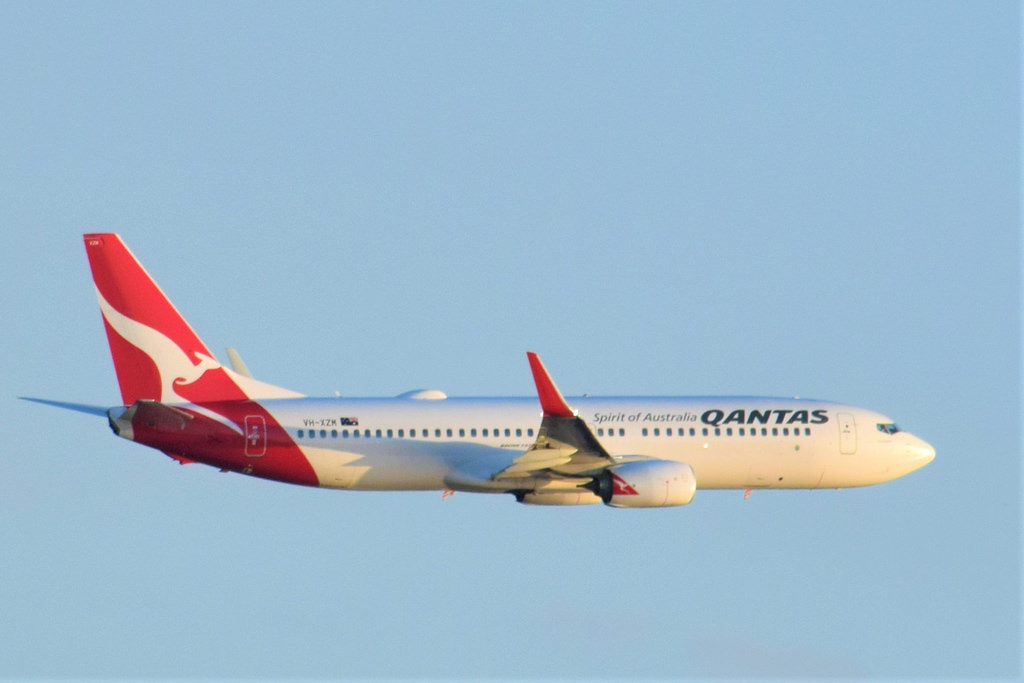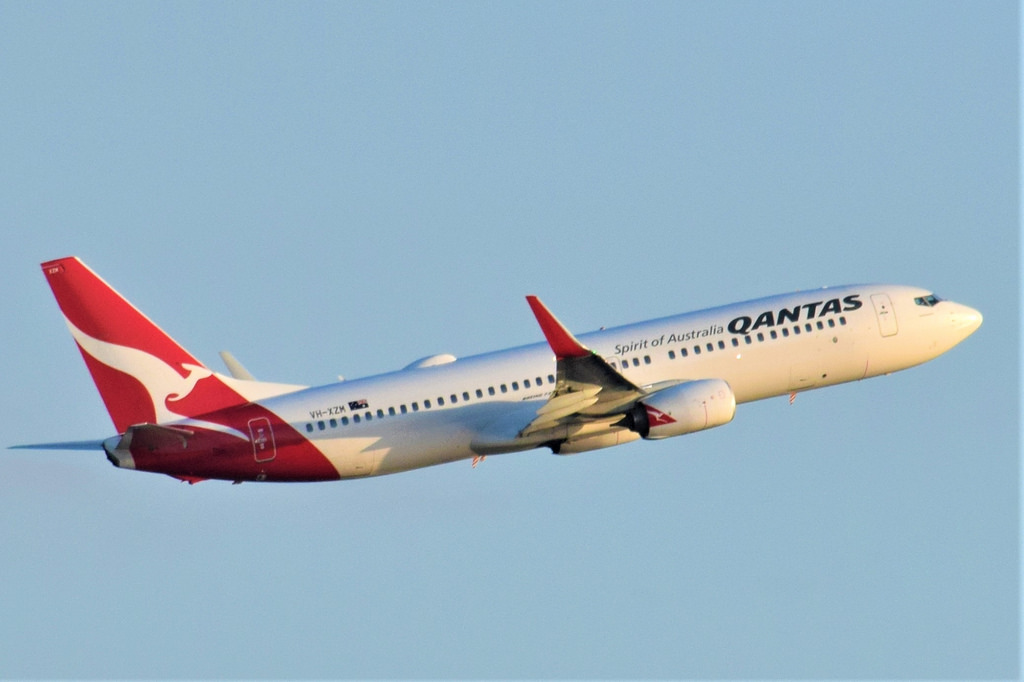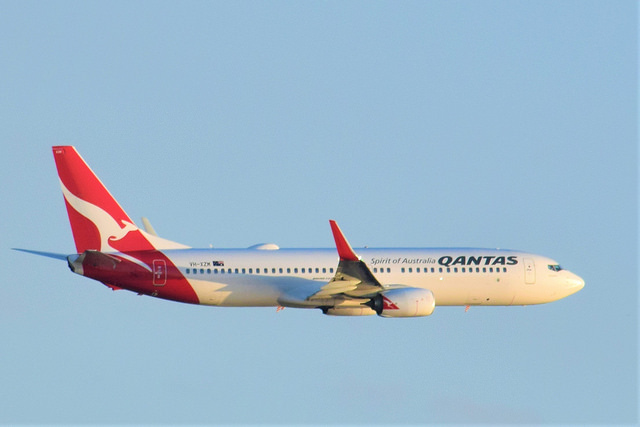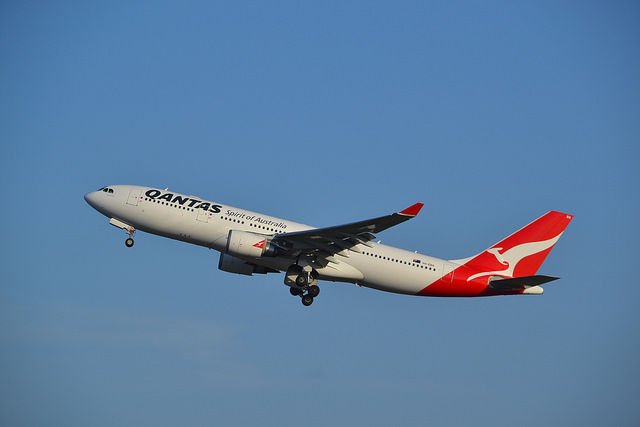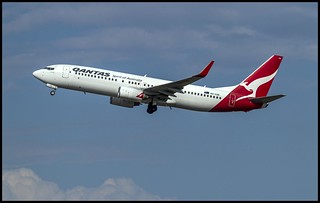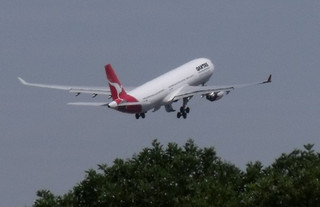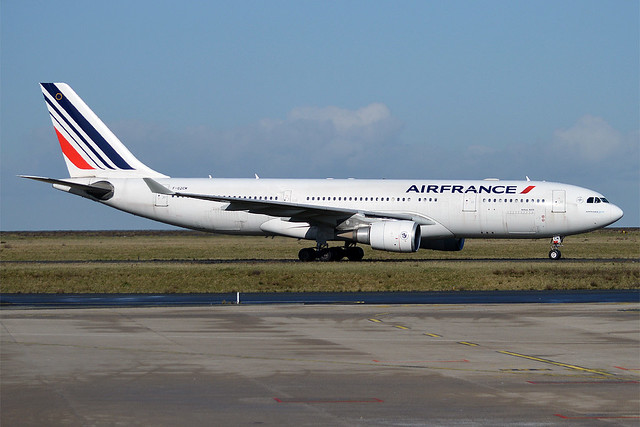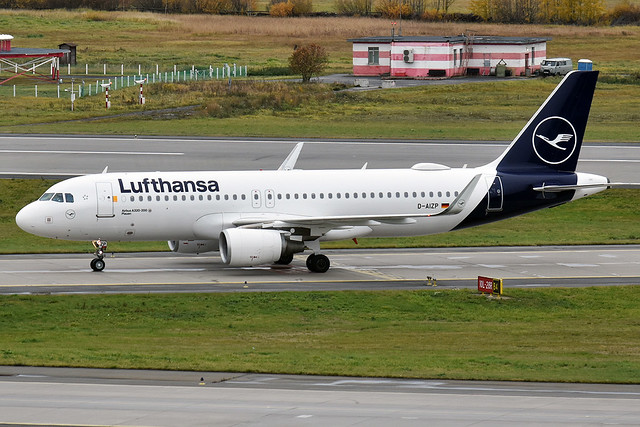Qantas B738 at Perth on Apr 28th 2018, runway incursion forces rejected takeoff
Last Update: October 1, 2020 / 10:32:34 GMT/Zulu time
Incident Facts
Date of incident
Apr 28, 2018
Classification
Incident
Cause
Runway incursion
Airline
Qantas
Flight number
QF-567
Departure
Sydney, Australia
Destination
Perth, Australia
Aircraft Registration
VH-XZM
Aircraft Type
Boeing 737-800
ICAO Type Designator
B738
Another Qantas Boeing 737-800, registration VH-VZL performing flight QF-582 from Perth,WA to Sydney,NS (Australia), was accelerating for takeoff from runway 06 when VH-XZM crossed the hold short line on taxiway J2 prompting tower to instruct VH-VZL to stop immediately. VH-VZL rejected takeoff and came to a stop near taxiway J2. The aircraft vacated the runway via taxiway A and returned to the apron.
VH-VZL was able to depart about one hour later.
Australia's TSB rated the occurrence a serious incident and opened an investigation. The ATSB wrote: "The area where the incident occurred is annotated on the En Route Supplement Australia (ERSA) as a runway incursion ‘hot spot’. The holding point on taxiway J2 prior to runway 06 is marked with a runway stop bar."
On Oct 1st 2020 the ATSB released their final report concluding the probable causes of the serious incident were:
Contributing factors
- The captain developed an incorrect mental model of the exit taxiways off runway 03, believing the aircraft would not have to cross runway 06 after exiting on either of the potential taxiways (J2 or D). As a result, the captain did not expect to cross a runway holding point or stop bar and, upon seeing the stop bar was illuminated, incorrectly thought that it must only apply to aircraft coming from the other direction.
- During the approach phase, the captain's workload as pilot monitoring was increased due to the first officer's low level of experience and air traffic control's request for a high-speed descent. This workload contributed to the omission of routine secondary tasks, such as requesting a taxiway D exit from the tower and pre-setting the surface movement control frequency.
- After vacating runway 03, the first officer focused inside the flight deck for a period of time to select the surface movement control frequency, instead of performing the more safety critical task of monitoring the aircraft's taxi path as it approached a known runway incursion hot spot.
- When approaching the holding point for runway 06, the captain briefly focused inside the flight deck to gain an understanding for the delay in changing to the next frequency. This reduced the time available to notice the holding point signs and lights ahead.
- The captain taxied passed the runway 06 holding point (with an illuminated stop bar) without an air traffic control clearance.
- After taxiing passed the illuminated stop bar, the captain was distracted by the presence of another aircraft on the apron. This focused the captain’s attention on the distant apron area, reducing the likelihood of visually identifying the runway immediately in front of the aircraft.
- During the approach briefing, the flight crew discussed taxiway J2 and taxiway D, but the flight crew did not discuss the potential threat of the hot spot associated with taxiway J2.
- Although Qantas provided detailed guidance to flight crews about the content of departure and approach briefings, it did not specifically require aerodrome hot spots to be briefed. [Safety issue]
- Although some aerodrome navigational charts in Australia had identified hot spot locations, they generally provided limited explanatory information to enhance flight crew understanding or awareness of why the hot spot was there and what actions they could take to mitigate the associated risk.
- The location and design of taxiway J2 at Perth Airport significantly increased the risk of a runway incursion on runway 06/24 for aircraft landing on runway 03. Taxiway J2 was published as the preferred exit taxiway for jet aircraft and, although mitigation controls were in place, they were not sufficient to effectively reduce the risk of a runway incursion. [Safety issue]
- Although the flight crew of VH-VZL taking off on runway 06 were provided with an instruction to stop immediately to reject their take-off, no safety alert or instruction was provided to the flight crew of VH-XZM during the period between when the controllers received a stop bar violation alert (1442:04) and the captain applied the brakes at 1442:19.
Other factors that increased risk
- Airservices Australia’s configuration of the integrated tower automation suite (INTAS) at Perth Airport had resulted in a situation where controllers performing some combined roles had the INTAS aural and visual alerts inhibited at their workstation. As a result, controllers performing such combined roles would not receive a stop bar violation alert or runway incursion alert at their workstation. [Safety issue]
Other findings
- The stop bar alert and the aerodrome controller’s high level of situational awareness led to a timely instruction to the flight crew of VH-VZL to stop immediately.
- The high level of situational awareness of the VH-VZL flight crew significantly aided their immediate action to reject their take-off on runway 06 following the controller’s instruction.
The ATSB described the sequence of events:
On 28 April 2018, a Boeing 737-838 (737) aircraft, registered VH-XZM, was being operated by Qantas Airways Limited (Qantas) on a regular public transport flight from Sydney, New South Wales to Perth, Western Australia. The aircraft landed on runway 03 and exited using taxiway J2 (Figure 1). The aircraft did not stop at the runway 06 holding point and crossed an illuminated stop bar without an air traffic control (ATC) clearance.
VH-XZM’s incursion into the flight strip of runway 06 resulted in a rejected take-off of another Qantas Boeing 737 aircraft (VH-VZL), which was taking off from runway 06. VH-VZL’s wingtip passed about 15 m from the nose of VH-XZM at low speed before stopping.
The ATSB reported that as result of the occurrence the use of taxiway J2 was discontinued and the taxiway was removed from the aerodrome charts.
The ATSB analysed:
After landing on runway 03, VH-XZM vacated onto taxiway J2 and crossed the runway 06 holding point, with an illuminated stop bar, without an air traffic control (ATC) clearance. The aircraft continued to taxi toward runway 06. The aerodrome controller (ADC) received aural and visual alerts and instructed the crew of another aircraft (VH-VZL) taking off from runway 06 to stop immediately. The flight crew of the departing aircraft rejected their take-off, preventing further escalation of the occurrence.
This analysis will firstly discuss flight crew situational awareness, mental models and approach briefings associated with VH-XZM’s incursion onto runway 06. It will then discuss the design characteristics of taxiway J2 that increased the risk of incursion into runway 06/24. Finally, it will discuss a range of other safety factors identified during the investigation.
Flight crew situational awareness and mental model
The captain’s mental model of the expected taxi route from landing on runway 03 to the parking bay was incorrect. Instead of having to cross runway 06 on taxiway J2, the captain expected to be on a taxiway that connected straight to the apron and did not have cross the other active runway.
This incorrect mental model developed due to a combination of factors:
- The captain’s prior experiences landing at Perth had not used taxiway J2, instead generally landing on runway 03 and vacating at taxiway D or, more commonly, landing on runway 24 and vacating at taxiway J1. Both of these taxiways led directly onto the apron area with no runway crossing.
- The captain’s intention on this occasion was to use taxiway D, expecting they would be using taxiway D up until after they landed on runway 03.
- When taxiways were discussed during the approach briefing, the captain was referring to the apron chart rather than the full aerodrome chart, and this smaller chart did not include runway 03 or the full length of taxiway J2. When the first officer (FO) briefed that taxiway J2 needed to cross runway 06, the captain believed the FO was referring to crossing runway 06 while still on runway 03, and did not discuss this different (and incorrect) understanding with the FO.
- The approach briefing did not include a discussion of the airport’s known hot spots, including the hot spot associated with taxiway J2 (see also Approach briefing).
After landing, the captain realised that the request for taxiway D had not been made and quickly re-planned an exit onto taxiway J2, although continuing to have the same expectation that they not need to cross an active runway to reach the apron.
The runway holding point markings and warning lights would normally provide enough cues that an aircraft was approaching a runway holding point. In this case these cues were also supplemented by the very salient illuminated stop bar. However, although the captain saw the stop bar, it was not identified as a problem and no revision was made to the mental model of the taxiways, instead rationalising in a time-compressed situation that the stop bar had been installed incorrectly.
This behaviour is consistent with confirmation bias, or the tendency for people to seek information that confirms their hypotheses, interpret ambiguous evidence as supporting their hypotheses, and either discount or not seek information that contradicts their hypotheses (Wickens and others 2013). Confirmation bias is an inherent aspect of human decision-making and has been demonstrated to occur in a wide range of contexts.
Workload and distraction
High workload and time pressure lead to a reduction in the number of information sources a person will search, and the frequency or amount of time these sources are checked (Staal 2004). They also result in people conducting tasks with simpler strategies, relying on responses or strategies with which they are familiar, and persevering with a response or strategy even when it has proven to be unsuccessful (Staal 2004, Wickens and others 2013). In addition, people are likely to miss important cues and experience difficulty integrating disparate pieces of information and making sense of them (Burian and others 2005). Associated with the reduced search of information sources and increased perseverance, the influence of confirmation bias will be enhanced (Wickens and others 2013).
The flight crew’s overall workload during the approach and landing was not abnormally high. However, workload and distraction at key points in time combined together to result in a situation where the problem with the captain’s mental model was not detected and corrected.
During the approach phase, the captain's workload as pilot monitoring was increased due to the FO’s low level of experience and air traffic control's (ATC’s) request for a high-speed descent. This workload contributed to an omission of routine secondary tasks prior to landing, such as requesting a taxiway D exit from the tower and pre-setting the surface movement control (SMC) frequency in the radio’s standby frequency position.
These omissions were examples of prospective memory errors. Prospective memory relates to an intention to perform an action at a later time, and a delay between forming the intention and acting on it. It is known to be vulnerable to failure, and has been associated with many aviation accidents and incidents (Dismukes 2006). Conditions that increase this vulnerability include the delay between the intention to do a task and the execution of the task being filled with other activities, an interruption to a task sequence, and the cues or prompts to retrieve the intention from memory not being explicit. Neither of these tasks was associated with a specific checklist item (and by themselves were not important enough to be checklist items), and their omission was not detected until after landing.
After landing, when the captain realised the omission in not requesting taxiway D, the normal workload associated with landing was increased, associated with replanning the exit onto taxiway J2 while taking over control of the aircraft.
During the taxi phase, there was less time than would normally be the case to detect the problem. As the aircraft was crossing the runway edge, the runway 06 holding point was only about 176 m away. The captain’s delayed realisation that they needed to exit on taxiway J2, and misidentification of taxiway J2 as a rapid exit taxiway (RET), meant the aircraft entered J2 at a higher groundspeed than usual. The relatively high exit speed and relatively short distance to the runway 06 holding point meant that the flight crew only had limited time after leaving runway 03 to identify the problem before reaching the holding point.
During this period, a series of distractions occurred. More specifically:
- After vacating runway 03, the FO focussed attention inside the flight deck for a period of time to select the SMC frequency, instead of performing the more safety critical task of monitoring the aircraft's taxi path as it approached a known runway incursion hot spot. The FO assumed the captain would be stopping at the holding point and, focused on changing frequency and contacting the SMC, did not see that they had passed the holding point until about the time the captain was braking to stop.
- When approaching the holding point, the captain briefly went heads down to gain an understanding for the delay in changing to the SMC frequency and then advised the FO of the applicable SMC frequency. This reduced the time available to notice and comprehend the holding point signs, warning lights and stop bar lights ahead.
After passing the holding point, the presence of runway 06 ahead still provided an indication of a potential problem. However, the captain was distracted by the presence of another aircraft on the apron. This focused attention on the distant apron area and reduced the ability to visually identify the runway immediately in front of the aircraft. The FO was still primarily focused inside the flight deck during this period.
Approach briefing and approach briefing guidance
The approach briefing was the best opportunity for the flight crew to have established a shared and correct understanding of the requirements for the remainder of the flight, including the taxiway options. However, as already noted, they did not specifically discuss the taxiway J2 hot spot during the approach briefing, even though the FO had identified it on the aerodrome chart. Had the topic of the hot spot been raised and discussed in the briefing, as well as the main reason why it was a hot spot (that it led to another runway), the captain’s mental model of the taxiway J1/J2 layout would probably have been enhanced.
The International Civil Aviation Organization (ICAO) has emphasised that flight crews should prepare well in advance for departure and arrival at any airport, including reviewing hot spots before taxiing from the gate and prior to beginning descent. Accordingly, departure and approach briefings should contain a complete review of not just the expected taxi routes but potential routes as well, with special attention to any hot spots.
Qantas provided detailed guidance to flight crews on the content of approach briefings. Hot spots should have been considered a threat under the threat and error management section of the briefing guidance. However, since that briefing guidance contained no specific requirement to brief hot spots or runway incursion threats, it is likely that the presence of hot spots on a taxi route would not always be noted by a flight crew.
Although the aerodrome chart for Perth identified that the area around taxiway J2 was a runway incursion hot spot, it did not provide specific information about the nature of the threat or why it was a hot spot. Such information would better enable flight crews to understand how the hot spot may affect them. If flight crews are to effectively identify and plan mitigating actions to avoid runway incursions, they should be provided with detailed information to assist their understanding of the common reasons why previous flight crews have incurred a runway at particular locations.
Taxiway location and design
Airservices Australia data identified that the rate of runway incursions at Perth Airport was significantly higher than other major airports across Australia. A significant proportion of the Perth incursions occurred on taxiway J2 and, accordingly, it was designated as a hot spot. To assist with minimising the risk of incursions, stop bars and CASA approved runway identifier markings (in addition to other holding point markings and lights) had recently been introduced.
In addition to providing salient or conspicuous markings and cues about the position of a holding point, it is also important to ensure flight crews are provided sufficient time during a high workload period after landing to identify and comprehend runway holding point visual cues and to allow for ATC to intervene, if required, before an aircraft incurs a runway.
Taxiway J2 was not a rapid exit taxiway (RET), but it had some similar qualities: a relatively shallow intersection angle and a relatively wide curve radius. These characteristics led some pilots to use higher speeds when exiting runway 03. Although the intersection angle was not acute enough to actually be a RET, the angle would be difficult to judge while approaching it from the runway.
Flight data showed VH-XZM entered taxiway J2 at about 35 kt, which was slightly higher than the taxiway design limit of 31 kt. Flight data analysis of other flights provided by Qantas showed its aircraft commonly vacated runway 03 onto taxiway J2 at a relatively high speed.
In addition, taxiway J2 had a relatively short distance from the exit from runway 03 to the runway 06 holding point. This meant that flight crews had less time to see the holding point markings and an illuminated stop bar, especially if taxiing at higher speeds.
Taxiway J2 also led to a relatively complicated runway crossing point, with other taxiways intersecting at the same point. A complicated intersection can be difficult for crews to navigate and can draw their attention.
Overall, the location and design of taxiway J2 significantly increased the risk of a runway incursion on runway 06/24 for aircraft landing on runway 03. In particular, the following features made taxiway J2 problematic:
- a relatively shallow intersection angle from runway 03
- a wider than usual entry curve radius
- a relatively short distance from the turn to the runway 06 holding point
- the next intersection leading directly to a runway rather than a parallel taxiway
- the next intersection being relatively complicated
- the intersection adjoining the first two-thirds of runway 06.
In addition, the risk associated with taxiway J2 and runway incursions was exacerbated by it being made the preferred exit for landing off runway 03. Although many flight crews elected to use taxiway D instead, this required the crew to proactively make that request.
The introduction of stop bars in March 2018 would certainly have reduced the risk but, depending on the situation, not eliminated the risk. Although the exact sequence of events associated with this particular occurrence would have been difficult to predict beforehand, there was undoubtedly an increased risk of runway incursions that needed to be managed, and a range of scenarios that could have resulted in a high-risk runway incursion given the inherent limitations of the taxiway J2 location and design.
As previously noted, taxiway J2 had some features that would have made it appear similar to a RET. Flight crews would normally become aware of the existence of a RET from tables of information about an airport in the aerodrome charts. However, a flight crew may forget or may not brief the existence or absence of a RET among the potential taxiways that could be used. At the time of the occurrence there was no requirement in Australia for airports to use indicator lights at RETs to distinguish them from other taxiways, so there was no immediate way to identify a taxiway as a RET or otherwise during the landing. However, unless all RETs were equipped with the appropriate indicator lights, the absence of indicator lights at a particular taxiway may not be that effective as a cue. Overall, unless briefed otherwise, it would be generally safer for a flight crew to assume that a taxiway was not a RET and adjust the aircraft’s speed appropriately.
Air traffic control response
The ADC became aware of the problem on receipt of the first integrated tower automation suite (INTAS) alert. The ADC considered that, as VH-XZM had vacated and was clear of runway 03, the flight crew would most likely have changed over to the SMC frequency and therefore would have been unable to hear any safety alert instructions on the ADC frequency. Instead, an instruction was issued to VH-VZL to stop immediately.
A research study showed that the average time for tower controllers to act in response to a system alert was 4.6 seconds with a mean response duration of 2.3 seconds, with maximum response times being 8.1 seconds and 5.3 seconds respectively (Sanchez and others 2009). In this occurrence, the ADC transmitted the stop immediately instruction to the flight crew of VH-VZL about 7 seconds after the first alert, a time which included a period of blocked frequency from another aircraft transmitting.
The ADC’s action was effective in mitigating the consequence of the runway incursion. The ‘stop immediately’ instruction was simple and easily comprehended by the captain of VH-VZL, who was actively monitoring the developing situation and responded promptly to the ADC’s instruction.
However, although VH-VZL’s flight crew received a timely and clear instruction from ATC, VH-XZM’s flight crew did not receive any communication from ATC during the period after the first INTAS alert (1442:04) until 1442:26, when the SMC asked the flight crew if they were on the SMC frequency. This was after the captain had commenced braking (1442:19), and 10 seconds after the FO made initial contact with the SMC (when the FO was unware of the problem).
The exact reasons why the SMC did not issue an alert and instruction to the flight crew of VH-XZM are unclear. In response to the first INTAS alert, the SMC was aware of the developing problem. However, at that stage there may have been some doubt regarding whether the flight crew had switched over to the SMC frequency. In addition, the SMC was in the progress of providing a pushback clearance to another aircraft. The SMC had received training in issuing stop instructions as well as compromised separation recovery training.
The second INTAS alert at 1442:16 was broadcast on the ADC workstation’s speaker at the same time as the VH-XZM FO’s first transmission on the SMC frequency, to which the SMC did not reply. The SMC may have focussed on the more relevant event—the second INTAS alert—at this time and as a result did not process VH-XZM’s transmission. Nevertheless, even after hearing the ADC provide the other aircraft with a stop instruction (1442:11), a prompt instruction to VH-XZM was warranted to further minimise any potential collision risk. A stop immediately instruction over any frequency that the flight crew might be using would have led to a more rapid response from that flight crew.
Although not directly related to this occurrence, the investigation identified some limitations with ATC processes that increased the potential risk of other occurrences:
- Due to the way INTAS was configured at Perth, the SMC’s workstation did not directly receive INTAS alerts if the SMC position was combined with other positions. This meant that an SMC may not have received a salient warning that an aircraft under their control was at risk of collision. In this case, the SMC’s awareness of the runway incursion was raised as a result of the INTAS aural alert played through a speaker on the ADC’s workstation, but in other situations an SMC may not identify such an alert.
- Communication practices for runway crossings at Australian airports differed from those recommended by ICAO and used in some countries overseas. According to ICAO, runway crossings should be managed by the ADC, which ensured that flight crews of aircraft crossing a runway were aware of any instructions being issued to aircraft using that runway. In Australia (and some other countries), runway crossings were handled by the SMC and not the ADC. Having two aircraft on a runway at the same time but not requiring them to be on the same frequency does create the potential for flight crews not to be aware of the presence of the other aircraft at a critical point in time. However, Airservices Australia reported that it trialled a version of the ICAO-recommended approach and determined it did not reduce the risk of runway incursions and instead it introduced new safety issues and concerns in the Australian environment, including a potential reduction in controller situational awareness.
- Depending on how it was implemented, the ICAO-based approach could have required a flight crew to transfer to the SMC frequency, before the SMC then transferred them back to the ADC frequency prior to crossing the runway, which would have increased the complexity of communications at a location such as Perth Airport for aircraft landing on runway 03 and exiting on taxiway J2. One option that could have assisted with managing the unique problems associated with taxiway J2 was for the ADC to require flight crews landing on runway 03 and vacating on taxiway J2 to remain on the ADC frequency until after they crossed runway 06. However, introducing a unique approach to managing radio frequencies at one specific location in Australia could also increase risk. Alternatively, local procedures could have included advising a flight crew landing on runway 03 and exiting at taxiway J2 of the crossing runway hazard ahead.
Incident Facts
Date of incident
Apr 28, 2018
Classification
Incident
Cause
Runway incursion
Airline
Qantas
Flight number
QF-567
Departure
Sydney, Australia
Destination
Perth, Australia
Aircraft Registration
VH-XZM
Aircraft Type
Boeing 737-800
ICAO Type Designator
B738
This article is published under license from Avherald.com. © of text by Avherald.com.
Article source
You can read 2 more free articles without a subscription.
Subscribe now and continue reading without any limits!
Read unlimited articles and receive our daily update briefing. Gain better insights into what is happening in commercial aviation safety.
Send tip
Support AeroInside by sending a small tip amount.
Related articles
Qantas B738 near Karratha on Aug 9th 2022, lightning strike
A Qantas Boeing 737-800, registration VH-XZM performing flight QF-1206 from Perth,WA to Port Hedland,WA (Australia), was descending towards Port…
Qantas A332 enroute on Dec 23rd 2025, pressurization problem
A Qantas Airbus A330-200, registration VH-EBA performing flight QF-36 from Singapore (Singapore) to Melbourne,VI (Australia) with 240 people on…
Qantas B738 near Auckland on Sep 26th 2025, cargo fire indication
A Qantas Boeing 737-800, registration VH-VZE performing flight QF-141 from Sydney,NS (Australia) to Auckland (New Zealand), was descending towards…
Alliance E190 near Darwin on Sep 22nd 2025, loss of cabin pressure
An Alliance Airlines Embraer ERJ-190 on behalf of Qantas, registration VH-XVU performing flight QF-1889 from Darwin,NT to Cairns,QL (Australia), had…
Qantas A333 at Melbourne on Aug 10th 2025, hydraulic problems
A Qantas Airbus A330-300, registration VH-QPJ performing flight QF-29 from Melbourne,VI (Australia) to Hong Kong (China), was climbing out of…
Qantas B738 at Brisbane on May 4th 2024, severe turbulence injures 3, 4 people out of seats on landing
A Qantas Boeing 737-800, registration VH-VYK performing flight QF-520 from Sydney,NS to Brisbane,QL (Australia) with 143 passengers and 6 crew, was…
Newest articles
France A332 near Munich on Jan 4th 2026, toxic fumes on board
An Air France Airbus A330-200, registration F-GZCM performing flight AF-565 from Beirut (Lebanon) to Paris Charles de Gaulle (France), was enroute at…
Lufthansa A320 at Cluj on Jan 4th 2026, bird strike
A Lufthansa Airbus A320-200, registration D-AIZP performing flight LH-1668 from Munich (Germany) to Cluj (Romania), was on final approach to Cluj's…
Subscribe today
Are you researching aviation incidents? Get access to AeroInside Insights, unlimited read access and receive the daily newsletter.
Pick your plan and subscribePartner

ELITE Simulation Solutions is a leading global provider of Flight Simulation Training Devices, IFR training software as well as flight controls and related services. Find out more.
SafetyScan Pro provides streamlined access to thousands of aviation accident reports. Tailored for your safety management efforts. Book your demo today
AeroInside Blog
Popular aircraft
Airbus A320Boeing 737-800
Boeing 737-800 MAX
Popular airlines
American AirlinesUnited
Delta
Air Canada
Lufthansa
British Airways
